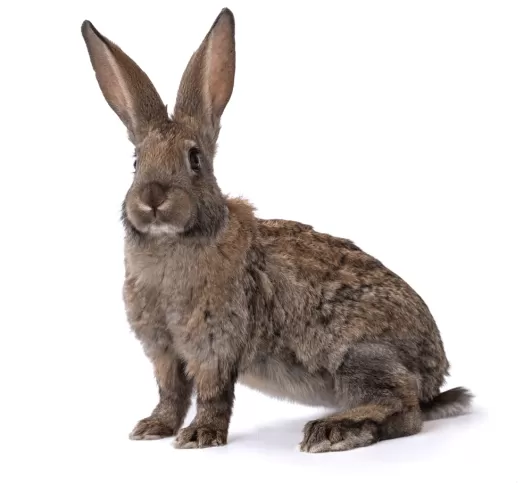Rabbit haemorrhagic disease (RHD) symptoms, when should we suspect?
Rabbit haemorrhagic disease (RHD) is a viral disease characterised by high morbidity and mortality. Most strains are so virulent that infected rabbits typically die without exhibiting RHD clinical signs. This makes it very difficult to obtain both real prevalence data in pet rabbits and clinical cases in which the animal has managed to survive the disease. Moreover, the outcome of the few published clinical cases is always fatal. Despite that, they help us understand when we should suspect rabbit haemorrhagic disease.
It can be caused by the classic strain (RHDV or GI.1), which only affects the European rabbit (Oryctolagus cuniculus), or by the variant strain (RHDV2 or GI.2), which affects both the European rabbit and some hares (Lepus), or has even been described in the cottontail (Sylvilagus). Both viruses belong to the lagovirus genus and have great fear resistance, which facilitates their transmission.

Cottontail

European rabbit

Hare
RHD Hyperacute Form
The incubation period is 1 to 3 days. The clinical course is usually hyperacute, which typically causes the rabbit's sudden death without previous rabbit haemorrhagic disease (RHD) clinical symptoms. Sometimes only a high fever is detected (>40°C), but they usually succumb to the disease 12 – 36 hours after its onset. This type of clinical presentation makes diagnosis difficult, since the cause of death is often not sought. However, from a necropsy it can easily be suspected that rabbit haemorrhagic disease was the cause of death.
During necropsy, the most serious lesions will be found in the liver, since it is the organ that contains the highest viral titre, as well as the lungs and the spleen. Primary hepatic necrosis, disseminated intravascular coagulation (DIC) in all organs and tissues and splenomegaly are frequently detected. Petechiae are evident in almost all organs and are accompanied by poor blood clotting. The virus must be detected to confirm the diagnosis. This is normally done by performing a PCR on liver samples.
RHD Acute Form
Acute infections may be accompanied by rabbit RHD symptoms such as anorexia, apathy, jaundice, fever, eyelid congestion and neurological symptoms such as opisthotonos, paralysis and ataxia. Rabbits occasionally present with respiratory signs (tracheitis, dyspnoea and cyanosis) and frothy, bloody nasal discharge. Tearing eyes, ocular haemorrhage and epistaxis may also occur. The course of this clinical presentation will depend on how the animal responds to supportive treatment. As such, it is difficult to make an accurate prognosis.
RHD Subacute Form
The subacute form is characterised by rabbit haemorrhagic disease clinical symptoms that are similar to but milder than the acute form. Rabbits that experience subacute infections often develop antibodies against RHDV that protect the animal against reinfection.
In both the acute and subacute forms, clinical testing is essential for diagnosing rabbit haemorrhagic disease. At the onset of infection, rabbits usually exhibit non-specific clinical signs such as anorexia, weight loss, jaundice or lethargy. However, clinical tests reveal signs of liver damage, with highly abnormal coagulation values, and haemorrhagic diathesis with disseminated intravascular coagulation (DIC). In terms of haematology, cases of thrombocytopenia, leukopenia with heteropenia and/or lymphopenia, as well as lymphocytosis have been documented. Regarding kidney values, abnormal creatinine and urea values are sometimes observed.
In summary, the main rabbit haemorrhagic disease clinical signs that should lead us to suspect that a rabbit is infected by virus are:
- Fever
- Jaundice
- Signs of liver damage
- Coagulation disorders
- Sudden death without clinical signs
Above all, RHD should be included as part of a differential diagnosis if the rabbit is not vaccinated or if vaccination protocols have not been correctly implemented. There are currently rabbit vaccines that can protect them against the classic strain, variant and even against highly virulent strains of RHDV2.
References
Bonvehi C, Ardiaca M, Montesinos A, Juan-Salles C, Gomez A, Teso B, et al. Clinicopathologic findings of naturally occurring Rabbit Hemorrhagic Disease Virus 2 infection in pet rabbits. Vet Clinic Pathol. (2019) 48:89–95. doi: 10.1111/vcp.12701
Soliman M, Rhaman M, Samy M, Mehana O, Nasef S. Molecular, clinical and pathological studies on viral rabbit hemorrhagic disease. Alex J Vet Sci. (2016) 48:20–6. doi: 10.5455/ajvs.207505
Abade Dos Santos FA, Magro C, Carvalho CL, Ruivo P, Duarte MD, Peleteiro MC. A Potential Atypical Case of Rabbit Haemorrhagic Disease in a Dwarf Rabbit. Animals (Basel). 2020 Dec 28;11(1):40. doi: 10.3390/ani11010040. PMID: 33379183; PMCID: PMC7823764.
Harcourt-Brown N, Silkstone M, Whitbread TJ, Harcourt-Brown FM. RHDV2 epidemic in UK pet rabbits. Part 1: clinical features, gross post mortem and histopathological findings. J Small Anim Pract. 2020 Jul;61(7):419-427. doi: 10.1111/jsap.13141. Epub 2020 May 8. PMID: 32383506; PMCID: PMC7496995.
